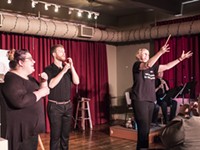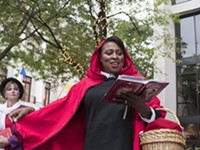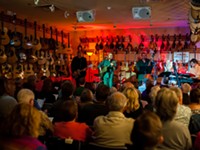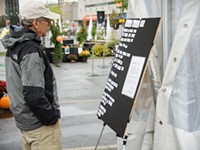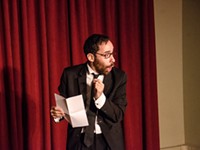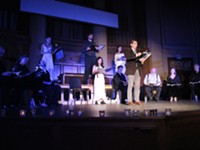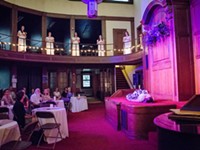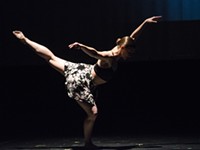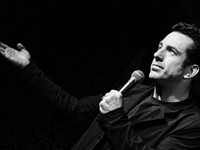The Eastman School's gorgeous Kilbourn Hall was again the backdrop of Table Top Opera's Fringe production. Commemorating the 100th anniversary of one of the bloodiest engagements in Europe's Great War, "Scarred by the Somme" echoed the tragic, grim themes of the group's 2015 program, "Kindertotenlieder" (songs on the death of children).
The show's organizer, Eastman professor Matthew Brown, introduced the multimedia production by telling the audience that his grandfather was one of the lucky ones who survived the Battle of the Somme. He said that his motivation for putting together this show was -- as someone who is critical of war -- to see through the eyes of a great artist whose life was directly impacted by its devastations.
A chamber ensemble of Eastman faculty, students, alum, and friends of the school performed an assortment of works by Claude Debussy, against a projected slideshow that described events leading up to the 1916 battle and its aftermath through images and text. Maps of Europe marred by skirmish lines were matched with the trumpet's mournful, dragging call to arms.
A stream of gruesome images, of fallen soldiers and parades of the wounded returning to cities that were reduced to rubble, flowed before the audience's eyes, representing Europe in 1914. The following year's title card introduced a grizzly slideshow of the trench warfare that stretched from the North Sea to Switzerland. Excellent, somber pacing in both music and imagery guided us through the relentless horrors of trench warfare: rats, poison gas, flamethrowers, machine guns, tanks, planes, and so on.
Interspersed with war history, we learn facts about Debussy's life -- that he was in his 50's during this time, and had struggled with recurrent cancer since 1909. He was haunted by childhood recollections of the Siege of Paris. Debussy's young friend and aspiring composer, Lieutenant Jacques Charlot, was killed in action. For him, for homeless infants, and for widows of war, Debussy composed masterful elegies and tributes.
The story of the actual battle is introduced with the clear, cutting peal of the trumpet, echoed immediately by the haunting, warm voice of the saxophone. Images of men swallowed by deep gashes carved in no man's land alternate with cavalry and chaos. Sounds of explosions and rapidly shifting scenes of carnage and confusion accompany heavy layers of instruments, and still the trumpet urges onward.
Despite losing more than 20,000 soldiers in a single day, the British claimed a victory, though little ground was actually gained, and all of Europe suffered devastating losses -- nearly 1 million were killed or wounded. In a very pointed, wry connection to recent events, a slide following celebratory newspaper headlines simply read: "Mission Accomplished!"
The following years are represented by images of disfigurement, funeral processions, and bombing raids in cities against tender tones of the horrified Debussy's work. He angrily criticized war as a means for powerful people to "further their careers" and lamented the fates of those caught up in its machine. And sadly, he never saw its end, as he died roughly eight months before the Allies declared victory.
A joyous sonata carried the last few minutes of the show, with images of many monuments to the dead, as well as the scarred earth. Trenches and a pox of craters still mark the fields today, softened by greenery and time. And slowly, subtlety, the poppy fields of France shift to the poppies patrolled by soldiers in present-day Afghanistan, and modern children huddling in devastated cities.
That was the only performance offered of "Scarred by the Somme."
